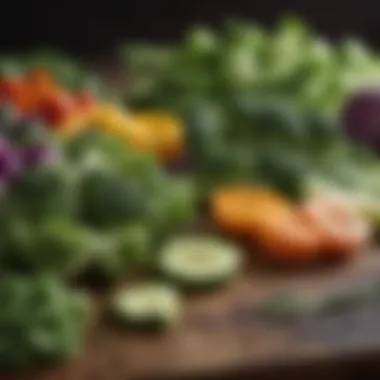Vegetables to Avoid on a Keto Diet: A Comprehensive Guide


Intro
The ketogenic diet has gained immense popularity in recent years, emphasizing low carbohydrate intake while promoting healthy fats. As many enthusiasts adopt this lifestyle, it's vital to understand which foods fit within these guidelines. Notably, while vegetables are an essential part of a balanced diet, not all of them align with the principles of the keto diet. Some varieties contain high levels of carbohydrates, making them less suitable for those striving to maintain ketosis.
This guide aims to clarify which vegetables to limit or steer clear of, the reasons behind these recommendations, and how their carbohydrate content can impact one’s nutritional goals. It will also explore alternative vegetables that are more compatible with a ketogenic approach, ensuring readers can make informed dietary choices during their keto journey.
Having clarity on these points is crucial for anyone navigating a keto diet. It allows individuals to enjoy a diverse range of foods without compromising their health objectives. Through this exploration, a deeper understanding will emerge regarding how to maintain a well-rounded diet while adhering to the principles of low-carb living.
Understanding the Keto Diet
The ketogenic diet has gained a lot of attention in recent years due to its distinct approach to nutrition. It promotes very low carbohydrate intake while increasing fat consumption. This method aims to shift the body into a state of ketosis, where it burns fat for fuel instead of carbohydrates. This section delves into the core principles of this dietary strategy, examining both its foundations and implications.
Principles of Ketosis
At its essence, ketosis is a metabolic state where the body begins to utilize fat as its primary energy source. This happens when glucose levels, derived from carbohydrates, become limited. As carbohydrate intake decreases, the body turns to its fat stores for energy, producing ketones, which serve as an alternative fuel.
Maintaining ketosis requires careful monitoring of carbohydrate intake. The general recommendation is to limit carbs to 20-50 grams per day, depending on individual factors such as activity level and metabolic health.
For effective ketosis:
- Limit Carbohydrates: Focus on reducing high-carb foods.
- Increase Healthy Fats: Include sources like olive oil, avocados, and nuts.
- Moderate Protein Intake: Too much protein can be converted into glucose, disrupting ketosis.
This way of eating can be beneficial for weight loss, improved energy levels, and better mental clarity. However, it may not be suitable for everyone. Individuals with certain health conditions or those who are pregnant should consult a healthcare professional before starting this diet.
Role of Carbohydrates
Carbohydrates play a critical role in traditional diets. They are one of the main macronutrients, providing energy, especially for high-intensity exercises. However, in the framework of a ketogenic diet, carbohydrates are seen as a hindrance to fat metabolism.
Here are some key points regarding the role of carbohydrates in a keto diet:
- Source of Energy: Carbs are typically used for immediate energy needs.
- Insulin Response: Carbohydrates trigger insulin release, which can store fat rather than burn it.
- Nutrient Considerations: While one should eliminate high-carb foods, it is essential to ensure adequate intake of nutrients through low-carb vegetables and other sources.
Ultimately, understanding the delicate balance of carbohydrates is vital for successful adherence to the ketogenic diet. The choice of vegetables, especially those low in carbohydrates, becomes crucial for individuals aiming to follow this dietary approach.
Defining Keto-Friendly Vegetables
Understanding which vegetables are keto-friendly is fundamental for anyone adopting a ketogenic diet. The vital aspect here involves the carbohydrate content in vegetables. Consuming vegetables that are high in carbohydrates can hinder the process of ketosis, which is aimed at burning fat for energy instead of glucose. Thus, when one defines keto-friendly vegetables, the focus is on their low carbohydrate and high fiber content, allowing for nutrient-dense options without negatively impacting ketosis.
Nutrient Composition
Nutrient composition plays a crucial role when selecting vegetables in a keto diet. Many vegetables contain fiber, vitamins, and minerals, which are necessary for overall health. However, some vegetables also have a high carbohydrate count. For example, spinach and zucchini have very low carbohydrates, while potatoes have high amounts that can quickly add up.
Low-carb vegetables typically offer bulk and flavor without significantly raising carbohydrate intake. They include options like broccoli, cauliflower, and bell peppers. These options not only contribute to one's daily intake of vegetables but ensure compliance with the strict carbohydrate limits often associated with a ketogenic eating plan. Moreover, consuming a variety of these vegetables will also help meet different nutritional needs, such as antioxidants and phytonutrients.
Impact on Insulin Levels
Another essential factor to consider is the impact of various vegetables on insulin levels. Foods that raise insulin often contain high amounts of carbohydrates. With a ketogenic diet, maintaining low insulin levels is critical for aiding fat metabolism and ensuring sustained energy levels.


When high-carb vegetables are consumed, they can cause spikes in insulin. This can counteract the goals of a ketogenic lifestyle. For instance, eating sweet potatoes or corn can lead to higher insulin production, making it more difficult to reach or maintain ketosis. On the other hand, non-starchy vegetables like cucumbers and asparagus are less likely to affect insulin levels negatively. Choosing the right vegetables is thus essential for controlling insulin and promoting a successful keto journey.
Key takeaway: Not all vegetables are created equal in the context of a ketogenic diet. Understanding their nutrient composition and impact on insulin levels will guide you in making better choices.
High-Carbohydrate Vegetables to Avoid
Understanding which vegetables to minimize or avoid is essential for those adhering to a keto diet. High-carbohydrate vegetables can compromise the very principles of ketosis. Since the goal of the keto diet is to keep carbohydrate intake low, consuming high-carb vegetables can hinder one’s progress toward reaching and maintaining that state of ketosis. Moreover, incorporating these vegetables can lead to unwanted weight gain, making it critical to understand their carbohydrate profiles.
Root Vegetables
Root vegetables are commonly known for their higher carbohydrate content. They are also rich in vitamins and minerals, but this comes with the downside of their carb levels.
Potatoes
Potatoes rank high in carbohydrates, making them unsuitable for a keto diet. A medium-sized potato can have around 37 grams of carbs. This high count is due to the starch content, which can quickly negate the effects of a low-carb plan. While potatoes offer significant nutritional benefits, such as Vitamin C and potassium, their carbohydrate load makes them a poor choice if one aims to stay in ketosis. Their starchy resilience may also make them more appealing in traditional diets but doesn't fit well into the low-carb framework.
Sweet Potatoes
Sweet potatoes, though often perceived as a healthier alternative to regular potatoes, still carry a substantial carb load. A medium sweet potato contains about 26 grams of carbohydrate. Despite their higher nutritional value, they can still disrupt ketosis. Sweet potatoes are rich in beta-carotene, vitamin A, and fiber, but the trade-off may not be worth it for someone strictly following keto guidelines. The temptation of their sweetness can be an issue for those battling cravings while reducing carbs.
Carrots
Carrots are a common vegetable but are often overlooked in the context of carb content. A cup of chopped carrots holds approximately 12 grams of carbohydrates. While they provide valuable antioxidants and vitamins, the sugar content in carrots can contribute to fluctuations in blood sugar levels. Thus, even these seemingly harmless vegetables can interfere with the quest for ketosis, despite being beneficial in moderate or higher carb diets.
Legumes
Legumes are another category that should be approached with caution on a keto diet. While they offer protein and fiber, they come with a carbohydrate higher than most leafy green vegetables.
Beans
Beans, including black beans and kidney beans, are relatively high in carbohydrates. One cup can contain upwards of 40 grams of carbs, along with beneficial protein and fiber. The balanced profile of beans is great for other diets, such as vegetarian or Mediterranean, but is counterproductive on a keto plan. Their ability to elevate blood sugar levels should not be underestimated.
Lentils
Lentils are another legume that packs a substantial carb punch, around 20 grams of carbohydrates per cooked cup. While they offer protein and iron, the high glycemic index of lentils means they can spike insulin levels, pushing one out of ketosis quite quickly. Their health benefits may often overshadow their carb concerns, thus requiring careful consideration in a keto setting.
Peas
Peas also have a surprisingly high carbohydrate content. A cup of green peas can have around 21 grams of carbs. Peas may contribute protein and essential nutrients but carry the risk of disrupting ketosis. Their small size can be deceiving, hiding a significant carb profile.
Certain Fruits and Vegetables
Certain fruits and vegetables are often overlooked in discussions about keto-friendly foods. These can inadvertently sabotage dietary efforts.
Corn
Corn tends to be a dietary staple in many cultures but should be avoided on a keto diet. A single ear of corn can yield about 27 grams of carbohydrates. Also, corn tends to have a high glycemic index, which can lead to rapid spikes in insulin levels, adversely affecting ketosis. The sweet taste and versatility of corn make it appealing, but its high carb content makes it a poor choice.
Beets


Beets are another vegetable that should be limited on a keto diet. A cup of boiled beets contains approximately 13 grams of carbohydrates. They offer antioxidants and nitrates that can help with blood flow, making them valuable for athletic performance. However, their sugar content cannot be ignored, rendering them less than ideal for those looking to maintain a strict low-carb intake.
Pumpkin
Pumpkin is often viewed as a nutritional powerhouse but can be quite high in carbohydrates. One cup of canned pumpkin contains about 12 grams of carbs. Though it is rich in vitamins, minerals, and fiber, its carbohydrate content can add up quickly in a keto meal plan. Thus, while pumpkin provides specific health benefits, it must be consumed considerately in a keto diet.
Effects of Consuming High-Carbohydrate Vegetables
Understanding the effects of consuming high-carbohydrate vegetables is crucial for individuals following a ketogenic diet. This dietary approach seeks to minimize carbohydrate intake to induce a state of ketosis. In ketosis, the body efficiently burns fat for fuel instead of relying on carbohydrates. Therefore, the consumption of high-carb vegetables can significantly undermine this goal. Knowing the consequences aids individuals in making informed decisions regarding their food choices.
Impact on Ketosis
The primary aim of a keto diet is to enter and maintain ketosis. High-carbohydrate vegetables, such as potatoes and sweet potatoes, introduce excess carbs into the diet. This can elevate blood sugar levels, leading to an increase in insulin. When insulin is high, the body reverts to using glucose for energy, effectively halting ketosis.
It's essential to pay close attention to the carbohydrate content in vegetables. Even small amounts of high-carb vegetables can cumulatively contribute to exceeding one's daily carbohydrate limit. To stay in ketosis, most people should aim for carbohydrate intake to be between 20 to 50 grams daily. Therefore, understanding the role of these vegetables plays a significant part in achieving and maintaining ketosis.
Potential Weight Gain
Another consideration when consuming high-carbohydrate vegetables is the risk of potential weight gain. A common expectation for individuals on a ketogenic diet is weight loss. However, if high-carb vegetables are included without caution, the body may not respond as desired. When insulin levels rise due to excess carbohydrates, it can lead to increased fat storage. Consequently, this results in either stagnation of weight loss or even unintentional weight gain.
Additionally, some high-carb vegetables may cause bloating or digestive discomfort, which can further impact an individual's perception of weight. For anyone committed to a keto lifestyle, it is vital to recognize how these vegetables can hinder goals regarding body composition and overall health. This awareness can lead to choosing better vegetable options and promoting more favorable outcomes in weight management.
"Understanding how high-carb vegetables interact with the keto diet can empower individuals to make better choices for their health."
In summary, recognizing the effects of high-carbohydrate vegetables is essential for anyone following a ketogenic diet. By examining their impact on ketosis and potential weight gain, individuals can make more informed decisions that support their dietary goals.
Altering Vegetable Choices
Choosing the right vegetables is crucial in maintaining a ketogenic diet. The central idea revolves around reducing carbohydrate intake while ensuring an adequate supply of essential nutrients. Altering vegetable choices means opting for those that are lower in carbs and higher in fiber, thereby supporting your overall health and allowing you to stay in ketosis. This section will discuss low-carb alternatives and how they can be seamlessly integrated into your meals.
Low-Carb Alternatives
Leafy Greens
Leafy greens are a cornerstone in any ketogenic meal plan. Their specific aspect lies in their low carbohydrate content and high nutrient density. Vegetables like spinach, kale, and Swiss chard are particularly favored for those on a keto diet. They offer a rich supply of vitamins A, C, and K while remaining low in calories.
Key characteristic of leafy greens: They are very low in carbs, which makes them a beneficial choice for people wanting to stay in ketosis.
A unique feature of leafy greens is their high water content, which contributes to hydration without adding calories. However, while leafy greens have numerous benefits, overconsumption can lead to digestive discomfort for some individuals due to their high fiber content.
Cruciferous Vegetables
Cruciferous vegetables like broccoli, cauliflower, and Brussels sprouts provide significant health benefits. The specific aspect of these vegetables is their ability to deliver crucial nutrients while being low in carbohydrates. Cruciferous vegetables are popular choices in the keto community, primarily due to their fiber content and antioxidant properties.
Key characteristic of cruciferous vegetables: They typically contain compounds that support detoxification and may help reduce inflammation, which is vital for maintaining overall health on a ketotic diet.
A unique feature of these vegetables is that they can serve as substitutes for traditional higher-carb foods. For example, cauliflower can be used to create a rice alternative or mashed potato substitute, providing advantages that can keep the diet varied yet compliant.


Avocado
Avocado is an outstanding choice for those following a ketogenic diet. Its specific aspect is the high fat content, particularly monounsaturated fats, which are beneficial for heart health. This creamy fruit is esteemed for its rich texture and nutrient profile.
Key characteristic of avocado: Unlike most fruits, avocados are low in carbohydrates. They add flavor and creaminess to dishes without the excess carbs.
A unique feature of avocados is the substantial amount of fiber they contain, which aids in digestion and helps maintain a feeling of fullness. While avocados are generally a very healthy addition to the diet, they are calorically dense, so moderation is crucial to maintain proper portions.
Incorporating Healthy Fats
Incorporating healthy fats into your meals can complement your vegetable choices significantly. Healthy fats from sources such as olive oil, coconut oil, and nuts not only enhance flavors but also aid in nutrient absorption. This approach allows for a balanced intake of beautiful nutrients while keeping carbohydrates in check.
Using healthy fats in cooking or dressing salads can elevate a meal’s nutritional profile while keeping it keto-friendly. This is an essential consideration for anyone serious about adhering to the principles of the ketogenic diet.
Reading Labels: Hidden Carbs
The ketogenic diet requires careful attention to food choices, especially vegetables. Many people are unaware that vegetables can harbor hidden carbohydrates, which can disrupt ketosis. Understanding how to read labels effectively is crucial for anyone committed to a keto lifestyle. It not only helps you make informed choices but also allows you to maintain your dietary goals.
Understanding Nutrition Facts
Nutrition labels, mandated by various food regulation authorities, serve as valuable tools for discerning your vegetable choices. They provide essential information, including total carbohydrates, dietary fiber, and sugars. A critical element is net carbs, calculated by subtracting fiber from total carbohydrates. For example, if a vegetable contains 10 grams of total carbs and 3 grams of fiber, it has 7 grams of net carbs.
In the context of a keto diet, keeping net carbs low is essential. When examining a label, always prioritize the serving size indicated, as this can significantly affect the overall carb count. Even low-carb vegetables may lead you astray if consumed in large quantities.
Moreover, pay attention to any added ingredients. Some processed vegetable products may contain sauces or mixtures that elevate their carb content. Always look beyond the surface of the visible ingredients and assess the complete label for hidden challenges.
Identifying High-Carb Ingredients
Identifying high-carb ingredients is a skill that can greatly benefit anyone on a keto diet. Familiarize yourself with common additives and hidden sugars that often appear in processed vegetable products. Ingredients such as corn syrup, maltodextrin, or starchy additives can increase carb counts substantially.
Here are a few tips to spot high-carb ingredients effectively:
- Check ingredient lists: Ingredients are listed in order of quantity. If a high-carb item appears early in the list, it’s best to avoid that product.
- Look for code names: Many sugars are disguised under various names, use tools like the Food Ingredients Dictionary to decipher them.
- Research vegetable-based sauces: These can contain excessive sugar or starches, tampering with the carb content of otherwise healthy vegetables.
- Trust your food sources: Buying fresh vegetables over processed ones helps in reducing the risk of unintentional carb intake.
"Being vigilant about labeling can be the difference between sticking to keto and falling out of ketosis."
Culmination
The conclusion serves as a critical element in this article by encapsulating the core insights into the impact of vegetable choices on a ketogenic diet. Understanding which vegetables to limit or avoid is paramount for anyone serious about maintaining a state of ketosis. It summarizes the vital points discussed, echoing the profound importance of maintaining balance in macronutrient intake.
In this article, we have dissected the high-carbohydrate vegetables, explored their ramifications on insulin levels, and analyzed their effects on ketosis. An awareness of these factors can greatly aid individuals in making informed decisions. Readers should remember that not all vegetables offer the same nutritional profile, and choices must be guided by their carbohydrate content.
Moreover, considering the potential for weight gain can motivate individuals to take these recommendations seriously. While many vegetables carry excellent health benefits, in the context of a keto diet, focusing on low-carb alternatives is essential.
"Decisions made in the kitchen reflect the commitment to one's dietary goals."
Ultimately, a strong grasp of these concepts can empower individuals to tailor their food choices more effectively, paving the way for success in their ketogenic journey.
Summary of Key Points
- The ketogenic diet requires careful consideration of vegetable choices.
- High-carbohydrate vegetables can disrupt ketosis and lead to weight gain.
- Awareness of nutrient composition is crucial for maintaining the diet's principles.
- Low-carb alternatives, like leafy greens and avocado, provide better options.
- Reading labels is pivotal in identifying hidden carbs in various vegetables.
Final Thoughts on Keto Vegetables
By incorporating beneficial and compatible foods, one can enjoy a diverse diet that supports weight loss and health. Remember that knowledge is your best ally. Stay informed, read labels, and explore low-carb vegetables that align with keto principles. This approach can lead to sustainable health benefits and a more fulfilling dietary experience.







